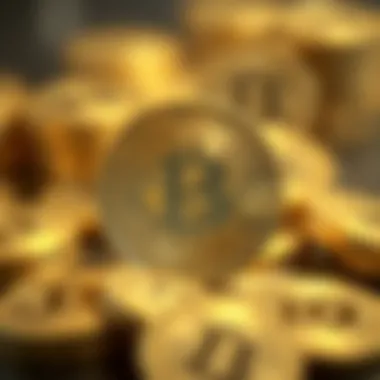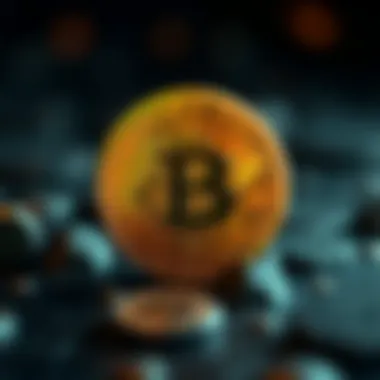Understanding Non-Fungible Tokens: Definitions and Implications


Intro
In the ever-evolving landscape of digital assets, non-fungible tokens (NFTs) have emerged as a revolutionary force. Unlike their more traditional counterparts, such as currencies or commodities, NFTs offer a unique proposition in the digital economy. This article aims to disentangle the complexities of NFTs, diving into what they are, how they differ from other blockchain assets, and the myriad implications they hold for various sectors.
With the increasing adoption of blockchain technology, understanding the fundamentals of cryptocurrencies is paramount. This serves as the foundation for grasping the distinctiveness of NFTs. Moreover, as the digital marketplace expands, discerning investors and enthusiasts must navigate the fluctuations in NFT values and the challenges surrounding regulation.
Grasping the essence of NFTs entails more than mere definitions; it requires a comprehensive look at their roles in art, gaming, collectibles, and beyond. As discussed in this article, NFTs are more than just a passing fad. They symbolize a shift in how ownership and value are perceived in the digital realm. Let’s explore the fundamental concepts that frame this innovation.
Crypto Fundamentals
Understanding Blockchain Technology
At the core of non-fungible tokens lies blockchain technology, a decentralized ledger system that ensures transparency and security. Unlike traditional databases, blockchains store information in blocks that are linked together, making it nearly impossible to alter past records without altering all subsequent blocks. This characteristic of immutability is crucial in establishing the uniqueness of NFTs.
Blockchain technology has redefined trust in digital transactions. By providing a ppublic verifiability framework, it allows creators and buyers to engage without a need for intermediaries.
Cryptocurrency Types and Their Uses
While NFTs stand apart from conventional cryptocurrencies like Bitcoin and Ethereum, they belong to the same technological framework. Distinguishing between fungible and non-fungible assets is pivotal. Fungible tokens, such as Bitcoin, can be exchanged on a one-to-one basis, as each unit holds the same value. On the contrary, NFTs are one-of-a-kind digital assets that represent ownership of a specific piece of content, be it art, music, or virtual real estate.
Several cryptocurrencies facilitate NFT transactions, with Ethereum being the most prominent. It allows for the creation of smart contracts—self-executing contracts with the terms of the agreement directly written into code. This has opened the floodgates for artists and creators to monetize their talents in ways that were previously unimaginable.
NFT Market Dynamics
Valuation and Market Trends
Navigating the NFT marketplace presents its own set of challenges, often characterized by volatility and speculation. The value of an NFT can be influenced by various factors including rarity, demand, and the reputation of the creator. Artists, developers, and collectors must pay attention to market dynamics to substantiate their investment decisions.
Regulatory Challenges
As the NFT landscape continues to mature, regulatory scrutiny is likely to increase. Governments around the world are grappling with how to categorize and regulate these digital assets. Issues of copyright, ownership rights, and taxation are at the forefront of discussions. Investors must stay informed to mitigate potential risks associated with regulatory developments.
Understanding non-fungible tokens is crucial for anyone looking to navigate the rapidly changing digital economy. By unraveling the complexities of blockchain and cryptocurrency, investors, tech experts, and enthusiasts can position themselves effectively within this new realm. Whether through art, gaming, or other sectors, NFTs are significantly reshaping the understanding of ownership and value in the digital age.
For more detailed insights, you can explore the following resources:
- Wikipedia on NFTs
- Britannica's article on Blockchain technology
- Reddit discussions on Crypto
- Government regulations on Digital Assets
Defining Non-Fungible Tokens
In today’s digital terrain, non-fungible tokens (NFTs) are emerging as a game changer, representing a new frontier in the ownership and exchange of digital and physical assets. While many relate them directly to art or collectibles, defining NFTs goes deeper—it explores unique assets that cannot be replaced or exchanged on a one-to-one basis with others. This uniqueness propels the conversation around NFTs far beyond mere transactions, touching on ownership rights, provenance, and the cultural shifts accompanying digital assets.
Understanding Fungibility
Fungibility refers to the property of an asset whose individual units can be interchanged. Think of money; a ten-dollar bill can be swapped with another bill of the same value without any changes in worth. This is the essence of fungible assets. Bitcoin, for example, is fungible: one Bitcoin is worth the same as another Bitcoin. In contrast, non-fungible tokens embody a distinct value; each is unique and carries its own significance, resulting from features that set it apart from others, whether artistic, historical, or personal.
Characteristics of Non-Fungible Tokens
Non-fungible tokens present a medley of characteristics that establish their uniqueness:
- Unique Identification: Every NFT has a distinct identifier that sets it apart from others, a hallmark of its non-fungibility.
- Indivisibility: Unlike cryptocurrencies, many NFTs can't be divided or split into smaller units. They exist as whole items, reinforcing their individual identity.
- Ownership Transparency: Thanks to blockchain technology, ownership information is transparent and traceable. Anyone can verify the current owner and the history of transfers.
- Interoperability: NFTs can interact and be traded across various platforms and marketplaces, adding layers of flexibility and expanding their utility.
The convergence of these characteristics contributes to the burgeoning interest in NFTs, as they offer different dimensions of engagement and value.
Distinguishing NFTs from Cryptocurrencies
While both NFTs and cryptocurrencies operate on blockchain technology, they embody fundamentally different concepts. Cryptocurrencies like Bitcoin or Ethereum are designed for trading and fungibility. They act like digital cash, where one token can replace another without altering value. Conversely, the essence of NFTs lies in their uniqueness. Each NFT has a distinct value, often influenced by aspects such as rarity, creator reputation, and cultural significance.


The implications for users and creators are crucial. Artists and content creators can harness NFTs to establish ownership of their work in a way that was previously challenging in the digital realm, incentivizing originality and providing a new revenue stream.
Understanding these distinctions is vital for those looking to navigate this evolving landscape. As the NFT space continues to grow, both investors and creators must grasp these foundational differences to make informed decisions.
Technological Foundations of NFTs
The rise of non-fungible tokens is rooted in a complex interplay of several key technological elements. Understanding these foundations is crucial for grasping how NFTs have transformed the landscape of digital ownership and creativity. This section will explore the essential components that make NFTs work, examining blockchain technology, smart contracts, and interoperability across various platforms. A grasp of these fundamentals is not just academic; they reveal the reasons behind the NFT boom and the challenges ahead.
Blockchain Technology Explained
At the heart of NFTs lies blockchain technology, which, to put it simply, is a decentralized ledger that records transactions across multiple computers. This distributed transparency ensures that no single party can alter transaction history fraudulently.
For NFTs, blockchains like Ethereum provide the underlying infrastructure that validates ownership and scarcity. Unlike cryptocurrencies that focus on fungibility, NFTs are unique and indivisible, each linked to a distinct digital asset. This characteristic allows for verifiable proof of authenticity, which holds particular significance in markets where provenance is crucial, such as art or collectibles.
A key takeaway is that the decentralized nature of blockchain technology not only boosts security but also redefines ownership. In essence, the interplay of code and community establishes a framework where artists and creators can benefit directly from their work, avoiding intermediaries who traditionally take a cut.
Smart Contracts and Their Role
Diving deeper, smart contracts act as automated agreements that execute based on specific conditions. For NFTs, these are vital, as they determine how ownership changes hands and encapsulate any specific rights associated with the token.
When you purchase an NFT, a smart contract is deployed on the blockchain, which automatically records the transaction and updates the ownership. Beyond simple sales, smart contracts can enforce rules such as royalties for creators on subsequent sales. This feature is particularly revolutionary, offering artists ongoing revenue without needing to manage or monitor secondary marketplaces.
The functionality of these contracts ensures transparency and reduces the likelihood of disputes. It’s about creating an ecosystem where all participants can operate on equal footing, facilitated through self-executing agreements that are clear and tamper-proof.
Interoperability Across Platforms
The ability of NFTs to move seamlessly across various platforms underscores their potential versatility. Interoperability refers to the capacity of different blockchain networks and applications to communicate and work together. This is a critical aspect of the NFT experience because it allows artists, collectors, and enthusiasts to interact across multiple marketplaces and environments.
For instance, an NFT created in one platform, like OpenSea, can often be transferred to another platform, like Rarible, allowing collectors flexibility in showcasing or trading their assets. This broadens potential market access, making NFTs more valuable as they aren’t confined to a single ecosystem.
Furthermore, interoperability encourages collaborative projects within the NFT space. For example, a music artist might release NFT tracks that can be used in virtual reality games, bridging gaming, art, and music in innovative ways. Such cross-pollination not only expands the utility of each NFT but fosters a creative culture that thrives on collaboration.
Through understanding these technological foundations, we can appreciate the intricate mechanics that allow non-fungible tokens to exist, thrive, and reshape the very notion of ownership in a digital age.
Applications of Non-Fungible Tokens
The realm of Non-Fungible Tokens (NFTs) has taken the digital landscape by storm, creating avenues across various sectors that were once unfathomable. A closer look into the applications of NFTs reveals their vast significance not just as digital assets but as transformative tools influencing culture, ownership, and investments. In a society increasingly driven by technology, understanding these applications becomes essential for anyone keen on the evolving digital economy.
Art and Digital Copyright
Art has always been a canvas for expression, but with NFT technology, it has become a platform for ownership and investment. By enabling artists to tokenize their work, NFTs allow creators to establish verifiable proof of ownership and originality. This is not simply a trend but a genuine shift in protecting intellectual property. Artists like Beeple have shown the world that digital art can fetch millions, instilling confidence in creators that their works can hold substantial value.
A notable benefit here is the capacity for artists to earn royalties on secondary sales. Traditionally, once an artwork was sold, creators often lost any financial benefits from future transactions. With smart contracts, artists can automate royalty payments, ensuring they benefit from their talent throughout the duration of their art’s existence in the marketplace.
"NFTs are revolutionizing how we think about ownership in the digital age, particularly in the art world."
This change encourages more artists to enter the digital space without fearing exploitation. However, this also raises questions about copyright and how traditional art definitions adapt to this new digital reality. The nuances of law in different jurisdictions mean that what works in one region might not apply to another, warranting closer examination.
Gaming and Virtual Assets
The intersection of NFTs and gaming introduces a voluminous potential for players and developers alike. Video games are no longer just play; they’re also earning avenues. NFTs facilitate true ownership of in-game assets, meaning players can buy, sell, or trade items they truly own rather than simply leasing them from developers. Imagine spending hours collecting rare swords or skins, and then realizing you can sell these items for real money on an open market.
This model incentivizes player engagement significantly, as it turns gaming into a viable source of income. Games like Axie Infinity exemplify how players can generate income by participating in the ecosystem, earning from both gameplay and transactions involving NFTs.
However, this rise in monetization also raises ethical discussions about accessibility. Many games require significant financial investment to participate fully, creating potential socio-economic divides among players. Balancing profit with inclusivity will be crucial in this ever-evolving gaming landscape.
Collectibles and Memorabilia
Collectible items have long been a staple of fandom and devotion, and NFTs take this concept a step further into the digital age. Be it sports trading cards or music memorabilia, NFTs allow fans to own unique digital representations of their passions. Platforms like NBA Top Shot empower users to purchase, sell, and trade officially licensed highlights, creating new fandom experiences.


For collectors, this means authenticity and provenance are easily verifiable, eliminating the worry of counterfeits. Collectibles in the form of NFTs can represent anything from classic video game moments to historic sports achievements, all transacted seamlessly on blockchain networks. The thrill of ownership in these realms has a proven track record of making collectors and investors alike willing to engage at higher financial stakes.
Tokenization of Real Estate
The real estate sector has often been seen as a fortress for the affluent, but NFTs are beginning to potentially lower barriers to entry. By tokenizing properties, real estate markets leverage the benefits of fractional ownership, making property investment accessible to a wider audience. Investors can purchase a fraction of a property represented as an NFT, allowing them to partake in investment opportunities that were previously out of reach.
This paves the way for more liquidity in traditionally illiquid markets. Imagine selling a portion of your house as a digital asset, democratizing the investment landscape and facilitating real estate transactions faster and more transparently. While this innovation presents exciting possibilities, it also necessitates regulatory frameworks to protect investors and ensure equitable practices.
In sum, the applications of Non-Fungible Tokens are not mere curiosities but rather significant developments reshaping our understanding of ownership, investment, and culture. Their capacity to revolutionize industries, while posing unique challenges, signals an interesting journey ahead in the digital landscape.
Market Dynamics of NFTs
The ever-evolving landscape of non-fungible tokens (NFTs) is underpinned by a fluctuating market that often mirrors the whims of trends and technology. Understanding these dynamics is crucial, not only for investors looking to navigate this complex environment but also for tech experts and enthusiasts seeking to grasp the broader implications of these digital assets. This section discusses crucial aspects of NFT market dynamics, including valuation methods, the role of auctions, and how scarcity influences demand.
Understanding NFT Valuation
Valuation of NFTs can be a slippery slope. Unlike cryptocurrencies, which have relative stability in trading due to their fungibility, NFTs often derive their worth from subjective measures. The conception of value in the NFT space can be influenced by multiple factors:
- Rarity: The uniqueness of an NFT contributes majorly to its valuation. An artist's rare digital piece may fetch prices in the millions simply because there’s only one of its kind.
- Reputation: The creator's standing in the digital art world can also play a substantial role. Works by established artists like Beeple are likely to attract higher values than those of lesser-known creators.
- Historical Significance: Some NFT value comes from their place in digital history, such as the first tweet by Jack Dorsey, which sold as an NFT for a staggering amount.
Furthermore, active marketplaces are also key. Their visibility can dramatically impact how NFTs are perceived and valued.
Role of Auctions and Marketplaces
Auctions and digital marketplaces serve as critical platforms for buying and selling NFTs. Unlike traditional platforms, NFT marketplaces like OpenSea and Rarible are uniquely structured to accommodate both creators and collectors. Key elements of these platforms include:
- Bidding Wars: Auctions can create a tidal wave of excitement, as buyers compete to own a piece of digital history. This can inflate prices rapidly, sometimes with irrational exuberance.
- Community Feature: Engaging features allow collectors to follow creators, track price histories, and participate in forums that can influence buying trends. The community aspect fosters collaboration and peer influence.
- Transparency: Since transactions on blockchain are visible to all, it promotes a sense of trust albeit subject to the credibility of the platform involved.
These elements underline the organic nature of value in the NFT market. It evolves not just from the asset itself, but from the interaction and engagement of its community.
Impact of Scarcity on Demand
Scarcity is a cornerstone of economic principles affecting NFTs profoundly. The notion of exclusivity brings about a higher demand for certain tokens, and understanding this principle can clarify why some NFTs fetch exorbitant prices. Here’s how scarcity can shape the NFT scene:
- Limited Editions: Just like traditional art, NFTs marketed as limited editions tend to trigger higher demand. For instance, an artist might release only ten copies of a digital work. Collectors are often willing to pay a premium for the assurance that they possess something rare.
- Market Psychology: The fear of missing out (FOMO) drives many buyers into quick purchases, effectively raising prices.
- Cyclical Nature: Scarcity can create cycles within the market. When prices spike due to high demand, other creators may flood the market with NFTs, often leading to market corrections or downturns.
"In an age where everything is copied, owning something original is a badge of honor. Scarcity asserts that claim."
In summary, the dynamics of the NFT market are intricate yet fascinating; they encompass a blend of emotional and economic factors. Investors, artists, and collectors alike must navigate through this evolving realm with a keen eye on valuation, marketplace activities, and the intrinsic value that scarcity can offer. Monitoring these elements closely not only enriches one's understanding but also enhances future decision-making.
Cultural Impact of Non-Fungible Tokens
The emergence of Non-Fungible Tokens (NFTs) signals a shift in how we perceive ownership and creativity in the digital landscape. They serve not just as a new medium for transactions but as a means to recast culturally significant concepts like art, value, and identity. In today’s fast-paced digital world, understanding the ramifications of NFTs is crucial for everyone—from seasoned investors to casual observers of cultural trends. This section delves deep into the multifaceted territory of NFTs' cultural impact, discussing pivotal elements like ownership redefinition, artistic evolution, and their influence on popular culture.
Redefining Ownership in the Digital Age
The traditional notion of ownership has seen a seismic shift with the advent of NFTs. In a world where physical objects can be replicated endlessly, the concept of owning something unique gains a different flavor. With blockchain's irrefutable ledger, buyers find assurance in owning an original piece of digital art or a specific moment captured as a collectible. This redefinition of ownership extends its wings beyond mere assets, embedding itself within personal identity and cultural significance.
- Aspects of Ownership:
- Authenticity: Each NFT verifies its authenticity through digital signatures on the blockchain.
- Provenance: Buyers can trace the entire history of ownership, adding to its allure.
- Sustainability: Ownership shifting to digital mediums provides new ways to appreciate art and objects without physical constraints.
These elements combined mean that the narrative of ownership has transformed; it isn’t merely about possession, but about recognition and participation in a digital landscape. This change elevates the cultural conversation, as individuals now reflect on what it means to own art, music, and even tweets.
NFTs and the Evolution of Art
The art scene has historically thrived on change, and the introduction of NFTs is no exception. Artists are finding fresh avenues to express themselves, no longer limited by physical mediums or traditional galleries. They can reach audiences directly through platforms specializing in NFT sales like OpenSea or Rarible.
The democratization of art is evident here.


- Empowerment: Artists can receive a larger cut of the profits, especially since royalties can be encoded in smart contracts, ensuring ongoing income from future resales.
- Diversity: New artists emerge from niche backgrounds, bringing varied experiences and cultural perspectives to the forefront.
- Innovation: NFTs encourage experimentation in multimedia formats. Artists can craft interactive pieces that engage viewers in unprecedented ways.
As a result, art not only survives its evolution but flourishes, embracing new styles and concepts while retaining its essence as a medium of communication.
Influence on Popular Culture
The ripples of NFTs reach beyond just art—they've started a discussion in popular culture that can’t be ignored. From celebrities endorsing NFT art to athletes launching their unique collectibles, the phenomenon has exploded into mainstream consciousness. These digital tokens are not just art; they are a part of modern storytelling, forging new connections among creators, collectors, and audiences.
- Meme Culture: The viral nature of memes has found new life in NFT collections, making them collectible commodities rather than mere entertainment.
- Sporting and Celebrity Influence: Icons like LeBron James and Grimes have jumped on the bandwagon, creating exclusive NFTs that bear their unique signatures, blending fandom with investment opportunities.
- Real-Time Interaction: Concerts and performances, like those by the musician 3LAU, have utilized NFTs to create an interactive experience directly connecting fans to artists.
As NFTs continue to carve their niche, they are redefining how society interacts with culture, including how we celebrate creativity, engage with celebrities, and even how we experience our hobbies.
"NFTs are not just tokens; they represent ownership of a piece of culture, a slice of the digital kingdom that everyone can access yet only a few can claim as theirs.”
Regulatory and Legal Challenges
As non-fungible tokens (NFTs) gain traction across various industries, the importance of navigating regulatory and legal challenges becomes more pronounced. These hurdles can significantly affect how NFTs are bought, sold, and utilized in different markets. Since the NFT landscape is ever-evolving, understanding regulations not only shields investors and creators but also fosters a secure environment for all stakeholders. Navigating the legal terrain is no small feat, but it is essential for instituting a reliable framework that benefits all parties involved.
Intellectual Property Considerations
In the realm of NFTs, intellectual property (IP) poses a complex challenge. Unlike traditional assets, NFTs often carry the potential for rights that go beyond mere ownership. For instance, when someone purchases an NFT associated with a piece of art, the rights attached might vary widely. This includes rights to reproduce, distribute, or publicly display the artwork. Hence, it is critical for buyers to fully understand what rights they are acquiring.
The artist’s original rights remain an important factor—what rights does the artist retain, and what does the buyer actually get?
- Artistic Rights: These are traditionally held by the creator—can the art be copied or altered?
- Transferability: Can the buyer resell the NFT? If yes, are there any stipulations?
- Moral Rights: Some jurisdictions uphold an artist's moral rights even after the sale.
As NFTs cross borders of law and culture, the nuances of intellectual property become a hot topic.
Regulatory Frameworks in Different Jurisdictions
NFTs are not governed by a single set of regulations; instead, their regulatory frameworks vary across regions. This territorial nuance is a double-edged sword. On one end, it allows for localized development of NFT markets, but on the flip side, this leads to a patchwork of regulations that creators and investors must navigate.
For instance:
- In the United States, NFTs may be classified as securities based on how they’re marketed and sold. The Securities and Exchange Commission (SEC) is increasingly scrutinizing these tokens.
- In the European Union, impending regulations aim to create a more standardized landscape, although nuances exist among member states.
- In Asia, countries like China take a cautious approach, limiting cryptocurrency transactions while exploring blockchain technology.
Understanding local regulations is imperative, especially for those looking to sell NFTs internationally. For example, a platform catering to European customers may need to adhere to the General Data Protection Regulation (GDPR), affecting data handling practices. Keeping abreast of global changes will dictate whether a creator or an investor can successfully navigate the burgeoning NFT market.
“Regulatory clarity is essential for fostering trust in the NFT ecosystem, allowing artists and investors to engage without fear of unexpected legal consequences.”
In summary, the landscape is not just about creativity or investment; it also necessitates a nuanced understanding of legal and regulatory challenges. Those who can adeptly maneuver through these complexities will position themselves favorably in the NFT marketplace.
The Future of Non-Fungible Tokens
As we stand at the brink of a digital transformation, the future of non-fungible tokens (NFTs) emerges as a critical conversation topic in the realms of finance, technology, and culture. In the coming years, NFTs are likely to evolve beyond mere collectibles or digital art. Their intrinsic value may increasingly be appreciated across various sectors, from real estate transactions to identity verification. The implications of this evolution warrant careful examination, as they promise to shape the fabric of our digital economy and redefine ownership as we know it.
Innovation and Evolution in NFT Technology
Innovation is the lifeblood of NFTs. Future developments are anticipated to enhance their functionality, security, and integration into daily digital interactions.
For instance, we might see advancements in how NFTs leverage blockchain technology, enabling increased scalability and lower transaction fees. These improvements could pave the way for decentralized platforms that allow creators and consumers to interact without intermediaries. Also, novel approaches to minting NFTs may emerge, like the use of layer-2 solutions that offer faster and cheaper transactions, making NFTs more accessible to the average user.
One could argue that interoperability will play a pivotal role in this innovation landscape. The ability for NFTs to exist seamlessly across multiple platforms could create a more unified digital experience. Just imagine owning an NFT that grants you access to exclusive content or events across different websites!
Predictions for Market Trends
Market trends around NFTs are often subject to change, influenced by technological advancements, consumer interest, and regulatory developments. As we look ahead, a few potential trends can be observed that may reshape the NFT marketplace:
- Diversification of Use Cases: Beyond art and gaming, NFTs may find applications in sectors like insurance and supply chain management. For example, an NFT could serve as proof of authenticity for luxury goods or handle the transfer of rights for intellectual property.
- Institutional Investment: More businesses are likely to recognize the potential value of NFTs, leading to increased investment. Major corporations may start creating or acquiring NFTs to engage with their audience uniquely and innovatively.
- Sustainability Concerns: As environmental awareness grows, there could be a shift towards more eco-friendly NFT solutions. Proof-of-stake mechanisms and other sustainable alternatives may become the norm, alleviating the energy concerns associated with traditional proof-of-work systems.
The NFT market might experience volatility, but its foundational implications are set to remain significant in steering investment decisions.
Potential for Broader Adoption
The broader adoption of NFTs hinges on several factors. For one, education plays an important role. As more individuals understand NFTs' value and how to utilize them, we may see an uptick in participation. Content creators, brands, and audiences are beginning to see that NFTs represent far more than just digital images—they can encapsulate community membership, unique experiences, and even charitable contributions.
Another significant element for broader adoption is user experience. If platforms can streamline the purchasing process, even the least tech-savvy person may find it easier to engage with NFTs. Additionally, regulatory clarity may encourage more businesses to adopt NFTs. If legal frameworks can establish rights and protections, businesses might feel more secure in venturing into the NFT space.















